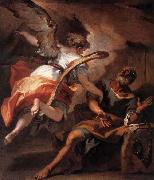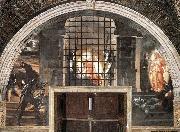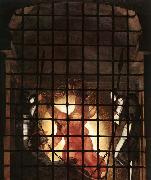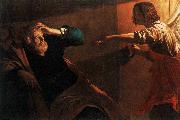Wholesale Oil Painting Reproductions No Minimum and Door to Door! |
|||||||||||
|
|
|||||||||||

|
|||||||||||
|
|
|
||||||||
All RICCI, Sebastiano Oil Paintings |
||||||||
|
|
||||||||
|
|
||||||||
|
Artist Introduction: Italian painter, Venetian school (b. 1659, Belluno, d. 1734, Venezia).Painter and draughtsman. He painted light and colourful religious, historical and mythological subjects with a fluid, painterly touch. His rediscovery of Paolo Veronese, whose settings and costumes he borrowed, was important to later Venetian painters. Sebastiano was an itinerant artist, celebrated throughout Europe. |
||||||||
|
|
||||||||
|
The Liberation of St Peter Painting ID:: 51993 |
1722
Oil on canvas |
|||||||
Height Width |
INS/CM Quality |
|||||||
|
X |
| |||||||
|
|
||||||||
All RAFFAELLO Sanzio Oil Paintings |
||||||||
|
|
||||||||
|
|
||||||||
|
Artist Introduction: Italian High Renaissance Painter, 1483-1520
Italian painter and architect. As a member of Perugino's workshop, he established his mastery by 17 and began receiving important commissions. In 1504 he moved to Florence, where he executed many of his famous Madonnas; his unity of composition and suppression of inessentials is evident in The Madonna of the Goldfinch (c. 1506). Though influenced by Leonardo da Vinci's chiaroscuro and sfumato, his figure types were his own creation, with round, gentle faces that reveal human sentiments raised to a sublime serenity. In 1508 he was summoned to Rome to decorate a suite of papal chambers in the Vatican. The frescoes in the Stanza della Segnatura are probably his greatest work; the most famous, The School of Athens (1510 C 11), is a complex and magnificently ordered allegory of secular knowledge showing Greek philosophers in an architectural setting. The Madonnas he painted in Rome show him turning away from his earlier work's serenity to emphasize movement and grandeur, partly under Michelangelo's High Renaissance influence. The Sistine Madonna (1513) shows the richness of colour and new boldness of compositional invention typical of his Roman period. He became the most important portraitist in Rome, designed 10 large tapestries to hang in the Sistine Chapel, designed a church and a chapel, assumed the direction of work on St. Peter's Basilica at the death of Donato Bramante, |
||||||||
|
|
||||||||
|
|
The Liberation of St Peter Painting ID:: 63805 |
1514 Fresco, width at base 660 cm Stanza di Eliodoro, Palazzi Pontifici, Vatican The story in the New Testament says that King Herod took Peter prisoner and intended to have him killed. In prison the Apostle was chained to two guards, but an angel of the Lord freed him despite the close watch. The fresco is dated 1514 on two painted tablets in the picture. The composition of this fresco clearly reflects the order and unity of the Mass of Bolsena. But the story is broken down into three distinct episodes, taken from the Acts of the Apostles. The first shows the dismay of the guards; the second the appearance of the Angel of Freedom in the saint's cell; the third, the bewildered Peter led by the hand of the divine messenger. The barred cell is on an upper level (like the altar in the Mass) and is reached by steps to the left and right. A group of agitated figures occupies the stairway at the left. Here, a soldier - whose armor reflects the light of the moon asks his sleepy and bewildered comrades what is going on. At right, the angel leads the stunned and still-sleepy St Peter past another sleeping guard. Here, for the first time, Raphael attempts a "night effect", using both the natural light of the moon and the autonomous light of the angel. Raphael's assistants played a greater role in painting the Eliodoro cycle than in the Stanza della Segnatura. This is clearly a consequence of the growing number of commissions which the Romans granted to Raphael. The hand of Giulio Romano, one of his most faithful pupils, is visible in the episode showing the Liberation of St Peter. This painting is the last fresco that can be attributed to Raphael with any certainty. The large cycles which follow (except for the Sibyls of Santa Maria della Pace) were entrusted mainly to assistants.Artist:RAFFAELLO Sanzio Title: The Liberation of St Peter Painted in 1501-1550 , Italian - - painting : religious |
||||||
Height Width |
INS/CM Quality |
|||||||
|
X |
| |||||||
|
|
||||||||
All RAFFAELLO Sanzio Oil Paintings |
||||||||
|
|
||||||||
|
|
||||||||
|
Artist Introduction: Italian High Renaissance Painter, 1483-1520
Italian painter and architect. As a member of Perugino's workshop, he established his mastery by 17 and began receiving important commissions. In 1504 he moved to Florence, where he executed many of his famous Madonnas; his unity of composition and suppression of inessentials is evident in The Madonna of the Goldfinch (c. 1506). Though influenced by Leonardo da Vinci's chiaroscuro and sfumato, his figure types were his own creation, with round, gentle faces that reveal human sentiments raised to a sublime serenity. In 1508 he was summoned to Rome to decorate a suite of papal chambers in the Vatican. The frescoes in the Stanza della Segnatura are probably his greatest work; the most famous, The School of Athens (1510 C 11), is a complex and magnificently ordered allegory of secular knowledge showing Greek philosophers in an architectural setting. The Madonnas he painted in Rome show him turning away from his earlier work's serenity to emphasize movement and grandeur, partly under Michelangelo's High Renaissance influence. The Sistine Madonna (1513) shows the richness of colour and new boldness of compositional invention typical of his Roman period. He became the most important portraitist in Rome, designed 10 large tapestries to hang in the Sistine Chapel, designed a church and a chapel, assumed the direction of work on St. Peter's Basilica at the death of Donato Bramante, |
||||||||
|
|
||||||||
|
|
The Liberation of St Peter Painting ID:: 63806 |
1514 Fresco, width of detail: 235 cm Stanza di Eliodoro, Palazzi Pontifici, Vatican The story in this fresco is broken down into three distinct episodes, taken from the Acts of the Apostles. The second (in the centre) shows the appearance of the Angel of Freedom in the saint's cell.Artist:RAFFAELLO Sanzio Title: The Liberation of St Peter (detail) Painted in 1501-1550 , Italian - - painting : religious |
||||||
Height Width |
INS/CM Quality |
|||||||
|
X |
| |||||||
|
|
||||||||
All Gerrit van Honthorst Oil Paintings |
||||||||
|
|
||||||||
|
|
||||||||
|
Artist Introduction: 1590-1656
Dutch
Gerrit Van Honthorst Galleries
Gerard van Honthorst (November 4, 1592 - April 27, 1656), also known as Gerrit van Honthorst and Gherardo della Notte, was a Dutch painter of Utrecht. He was brought up at the school of Abraham Bloemaert, who exchanged the style of the Franckens for that of the pseudo-Italians at the beginning of the 16th century.
Margareta Maria de Roodere and Her Parents by Gerrit van Honthorst (1652) Oil on canvas, 140 x 170 cm. Centraal Museum, UtrechtInfected thus early with a mania which came to be very general in the Netherlands, Honthorst went to Italy in 1616, where he copied the naturalism and eccentricities of Michelangelo da Caravaggio. Home again about 1620, after acquiring a considerable practice in Rome, he set up a school at Utrecht which flourished exceedingly. Together with his colleague Hendrick ter Brugghen, he represented the so-called Dutch Caravaggisti. In 1623 he was president of his gild at Utrecht, where he had married his cousin. He soon became so fashionable that Sir Dudley Carleton, then English envoy at The Hague, recommended his works to the earl of Arundel and Lord Dorchester. In 1626 he received a visit from Rubens, whom he painted as the honest man sought for and found by Diogenes.
The queen of Bohemia, sister of Charles I of England and electress palatine, being in exile in the Netherlands, gave Honthorst her countenance and asked him to teach her children drawing; and Honthorst, thus approved and courted, became known to her brother Charles I, who invited him to England in 1628. There he painted several portraits, and a vast allegory, now at Hampton Court, of Charles and his queen as Diana and Apollo in the clouds receiving the duke of Buckingham as Mercury and guardian of the king of Bohemia's children. Charles I, whose taste was flattered alike by the energy of Rubens and the elegance of Van Dyck, was thus first captivated by the fanciful mediocrity of Honthorst, who though a poor executant had luckily for himself caught, as Lord Arundel said, much of the manner of Caravaggio's colouring, then so much esteemed at Rome. |
||||||||
|
|
||||||||
|
|
The Liberation of St Peter Painting ID:: 95466 |
between 1616(1616) and 1618(1618)
Medium oil on canvas
cyf |
||||||
Height Width |
INS/CM Quality |
|||||||
|
X |
| |||||||
|
|
||||||||
|
Prev Next
|
||||||||
|
|
||||||||
|
Related Paintings to Gerrit van Honthorst :. |
||||||||
|
|
||||||||
|
CONTACT US |




